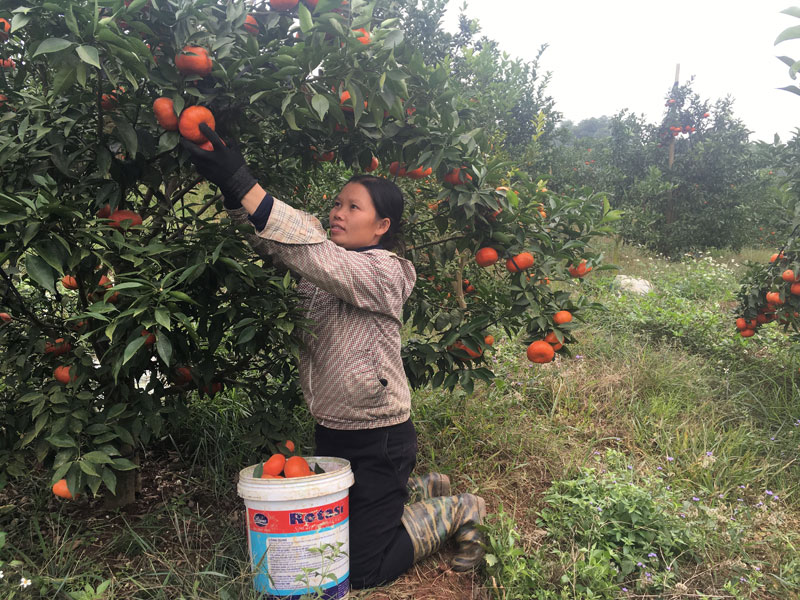
(HBO) Having collective trademark certification for Lac Son Doi seeds since 2015, Lac Son district is completing the procedures and conditions for two years (2018 - 2019) to have two specialties, Lac Son chicken and citrus fruits certified.

Huong Nhuong Commune (Lac Son) is actively
expanding the commercial orange areas.
Ri chicken (Mo chicken) has been the
specialty chicken of Hoa Binh in general and Lac Son in particular for a long
time. Lac Son Ri chicken living in the limestone mountains, self-feeding,
having thin skin, low fat, firm and aromatic meat, are well-known and popular
with a lot of people. From 2016 up till now, the district has coordinated with
the Department of Science and Technology and some related organizations to
organize seminars on preservation and development of chicken breeds and to
compile dossiers so that the competent agencies can consider and certify the
brand. At present, Lac Son Ri collective chicken brand is waiting for
recognition. In the process of building the brand, raising chicken in each
household in the area has strongly developed in terms of quality and scale
through propaganda and advocacy. The total number of poultry in the district is
1.2 million. Promoting the establishment of a number of chicken co-operatives
such as Huong Nhuong chicken co-operative, chicken breeding in Chi Thien, Vu
Lam and Yen Phu communes with the scale of the number of 10,000 - 20,000.
The area of citrus fruit trees in Lac Son
district has increased sharply over the past five years. By the end of October,
2018, the district has had 638 ha, in which there are 339,03 ha of orange
trees, 24 ha of tangerine trees and 214,07 ha of pomelo trees. The area of
citrus fruit trees of 214.8 ha, including 128 ha of orange, 80 ha of pomelo,
6.8 ha of tangerine trees have been harvested. Initially, citrus orchards were
established in Huong Nhuong, Thuong Coc, Tan My, My Thanh, Van Son, Binh Chan
communes. Some cooperatives and cooperative groups have called the planting
orange tree households to establish the advertising and selling points to
self-seek the product consumption. Through the quality evaluation, the quality
of orange and tangerine designs here are not inferior compared with the quality
of oranges and tangerines planted in other localities in the province. However,
with the area and the production of citrus fruit trees in 2018 and in the
coming years is forecasted to be increased, the "output" and product
prices are farmers’ great concern. According to the aspirations of the
households making products, Lac Son district is conducting the survey to
promote the brand of oranges and tangerines.
According to data from the Hoa Binh Provincial Party Committee, the industrial production index for the first six months of 2025 is estimated to have increased by 20% compared to the same period last year. This marks the highest year-on-year growth rate for this period since 2020.
In the first six months of 2025, Hoa Binh province’s export turnover was estimated at 1.145 billion USD, marking an 18.11% increase compared to the same period in 2024. Import turnover was estimated at $ 804 million, a 17.15% increase, which helped the province maintain a positive trade balance.
The lives of the ethnic minority farmers in Tan Lac district have gradually improved thanks to the new directions in agricultural production. This is a testament to the collective strength fostered through the professional associations and groups implemented by various levels of the district’s Farmers’ Union.
With the motto the "product quality comes first,” after nearly one year of establishment and operation, Muong village’s Clean Food Agricultural and Commercial Cooperative, located in Cau Hamlet, Hung Son Commune (Kim Boi district), has launched reputable, high-quality agricultural products to the market that are well-received by consumers. The products such as Muong village’s pork sausage, salt-cured chicken, and salt-cured pork hocks have gradually carved out a place in the market and they are on the path to obtaining the OCOP certification.
In the past, the phrase "bumper harvest, rock-bottom prices" was a familiar refrain for Vietnamese farmers engaged in fragmented, small-scale agriculture. But today, a new spirit is emerging across rural areas of Hoa Binh province - one of collaboration, organisation, and collective economic models that provide a stable foundation for production.
Maintaining growing area codes and packing facility codes in accordance with regulations is a mandatory requirement for agricultural products to be eligible for export. Recently, the Department of Agriculture and Environment of Hoa Binh province has intensified technical supervision of designated farming areas and packing facilities to safeguard the "green passport" that enables its products to access international markets.



